Cliff Hoene: the Singing Drummer
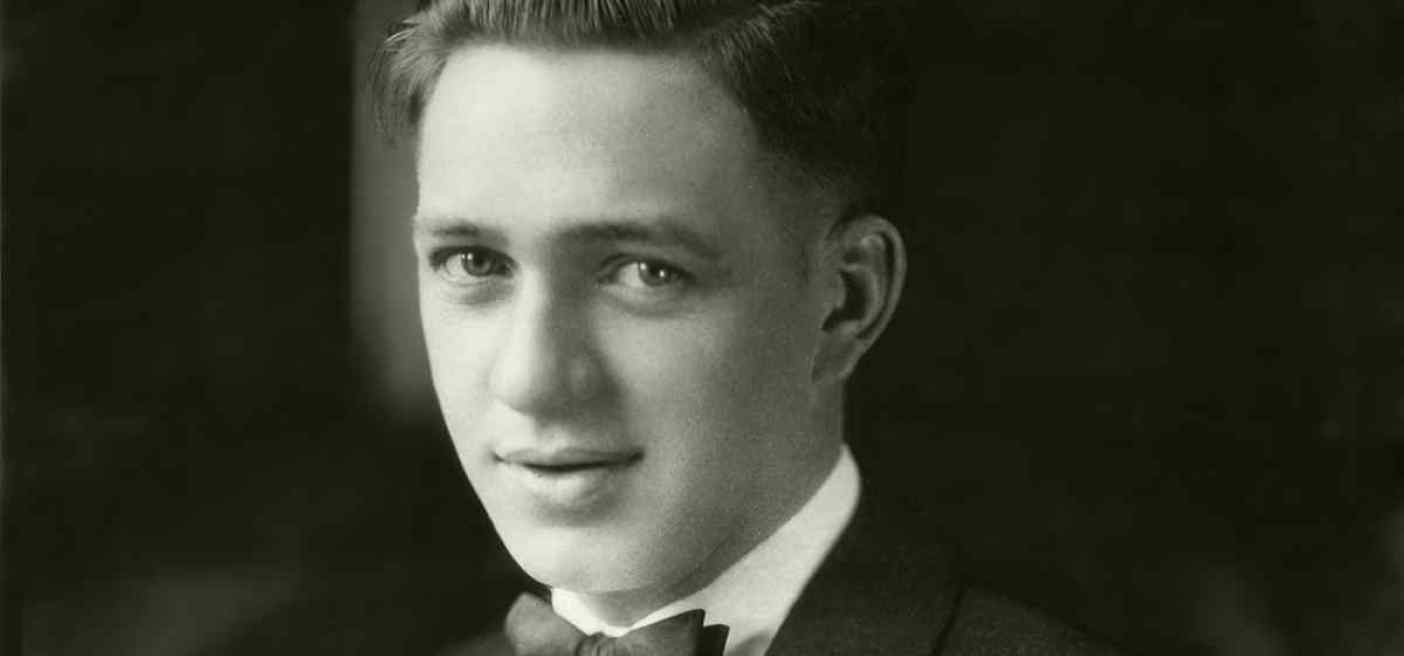
From his early years playing in church bands and studying mandolin, to picking up the drums to perform in early jazz orchestras and with military bands in the 1910s and 1920s, to a long career as a leader of his own dance band, Clifford Hoene was perhaps one of the most experienced and prolific Wausau-area musicians of his time.
The Early Years
By Clifford Hoene's own account, he was born into a strongly musical family, most of his family members could play at least one instrument and all of them could sing. By the age of 8, his parents enrolled him in music lessons where he studied the mandolin under Franz Winninger, the patriarch of a local vaudeville dynasty.
The Winninger Family
Back in 1881, Franz Winninger had left a career as a prominent violinist with Johann Strauss's famous orchestra in Vienna to move with his wife Rosalie and their four children, to the United States. While they initially took up farming on a homestead west of Athens, some difficult years on the farm caused them to move north to Ashland, where he fell back into show business. The entire musical family got into the act, and soon they decided to try life as as a touring Vaudeville act, traveling through the rough mining camps and lumber towns of Northern Wisconsin.
But in 1895, the family moved to Wausau, where Franz had been offered a job providing entertainment for the Ruder Brewing company's new Columbia Hall.
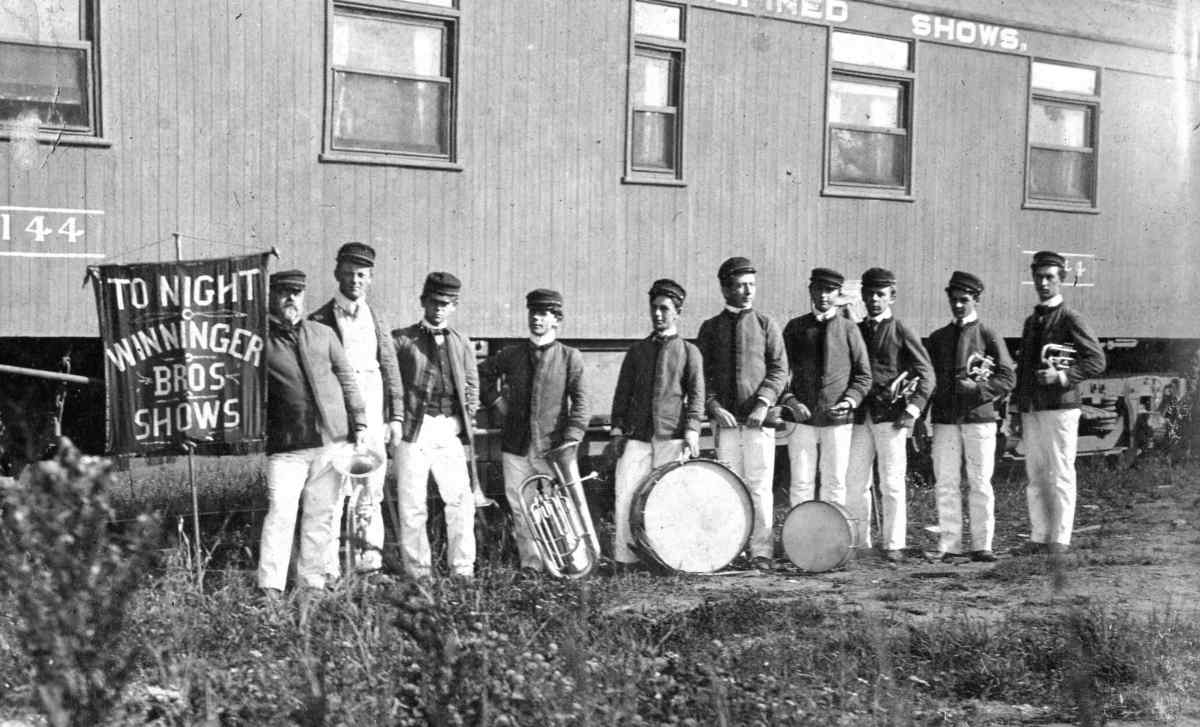
^ The Winninger Bros. traveling act. Father Franz on the left holding the banner.
By the turn of the century, Franz and Rosie's sons set off to tour as part of their own theatre troupes. Their son Frank for example, would tour for a few years at the head of his own troupe, before settling in Schofield, where he ran a theater/beergarden in the yard of his home. And of course there was Charlie, who would go on to find success as an actor on Broadway and early motion pictures.
^ Charlie Winninger had a number of staring roles, including playing Cap'n Andy in the original Broadway production of Showboat (1927), and the father to Judy Garland's character in Ziegfield Girls (1941). Here he is playing some "corny music" with Tommy Dorsey in the MGM musical, "Broadway Rhythm" (1944)
And so the young Cliff Hoene received an excellent introduction to the music business when he started mandolin lessons with the patriarch of the Winninger Dynasty in 1907.
The Mandolin
The mandolin was a very popular instrument for Americans around the turn of the century, and here in Wausau, several mandolin clubs were formed over the years.
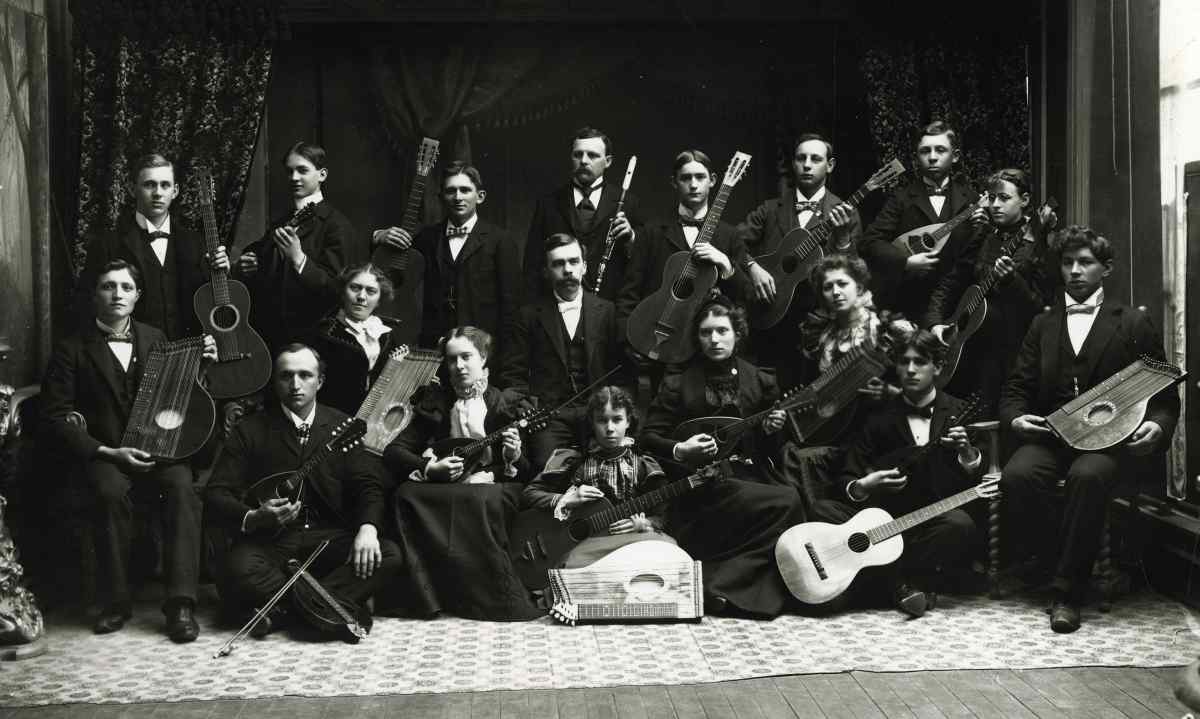
^ One of several mandolin and guitar clubs in Wausau over the years.
Around 1890, mandolin clubs started to emerge in Germany, and the ensemble quickly spread to became popular in places like Wisconsin that had large numbers of Central European immigrants. Despite the name, mandolin clubs typically included a variety of instruments besides the mandolin. These often included other stringed instruments like zithers, guitars, banjos, ukuleles, etc., as well as flutes and percussion.
^ Although most of the mandolin clubs in Wisconsin disappeared by the 1930s, some groups continue to perform, such as the Milwaukee Mandolin Orchestra. This video uploaded by Loland Kapuchinski features pictures from the group's first half century, set to a recording of "Granada" from the MMO's 2000 album, "Unplugged since 1900."
But while there were (and still are) places where concerts by mandolin clubs were popular, for the most part these groups did not entirely change the landscape of popular music. Instead the mandolin (and guitar) clubs tended to be a great way for locals to get together and socialize while learning to play music.
For his part, although the young Cliff Hoene spent a few years learning to play mandolin, it does not appear that he ever joined one of Wausau's mandolin clubs.
Church Bands
In 1909, the ten year old Clifford Hoene fell out of a hayloft and broke the little finger on his left hand, effectively ending his mandolin playing career. Instead, he joined up with one of the church bands. Towards the end of the 1800s, the popularity of brass bands led to the rise of these bands that were organized through a local church.
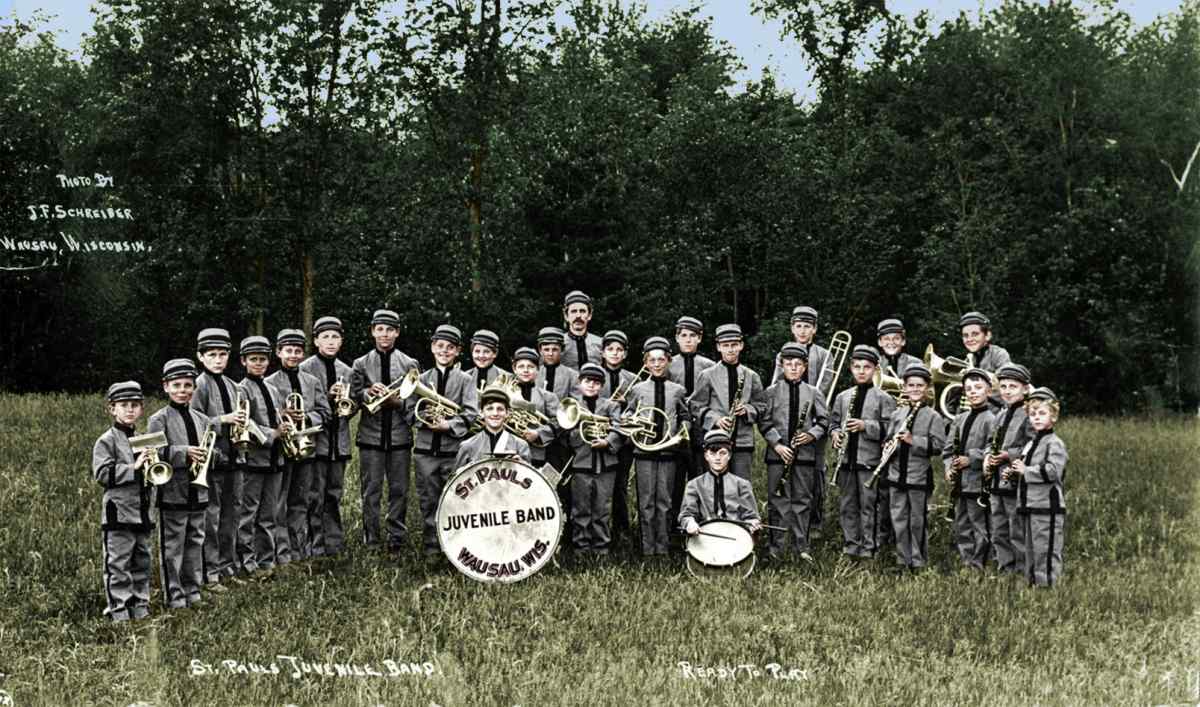
Often these church bands were specifically organized as juvenile bands, which was itself a traditional form for bands that dated back to a juvenile band formed in Wausau around 1883 by Frank Schubert. Although the juvenile band would largely fall out of favor as the public school system embraced music and the concert band in the 1920s and 1930s (which would finally let girls play in bands too), they did help raise the level of musicianship in the area by giving local boys a chance to learn to play an instrument or two.
But in his case, Cliff Hoene was brought in to play for a church band that was mostly made up of adults. The St. Stephanus Band (organized through St. Stephen's Church) was probably the most active and prominent church band of the early years of the twentieth century--although other church bands would soon challenge that assertion with their excellent musicianship. For example the Trinity Church band, organized in 1908, and quickly became a favorite as well.
Interestingly, in Wausau the prominent church bands typically were Lutheran, but other denominations did help form bands too (for example Spencer's Methodists sponsored a band before the turn of the century).
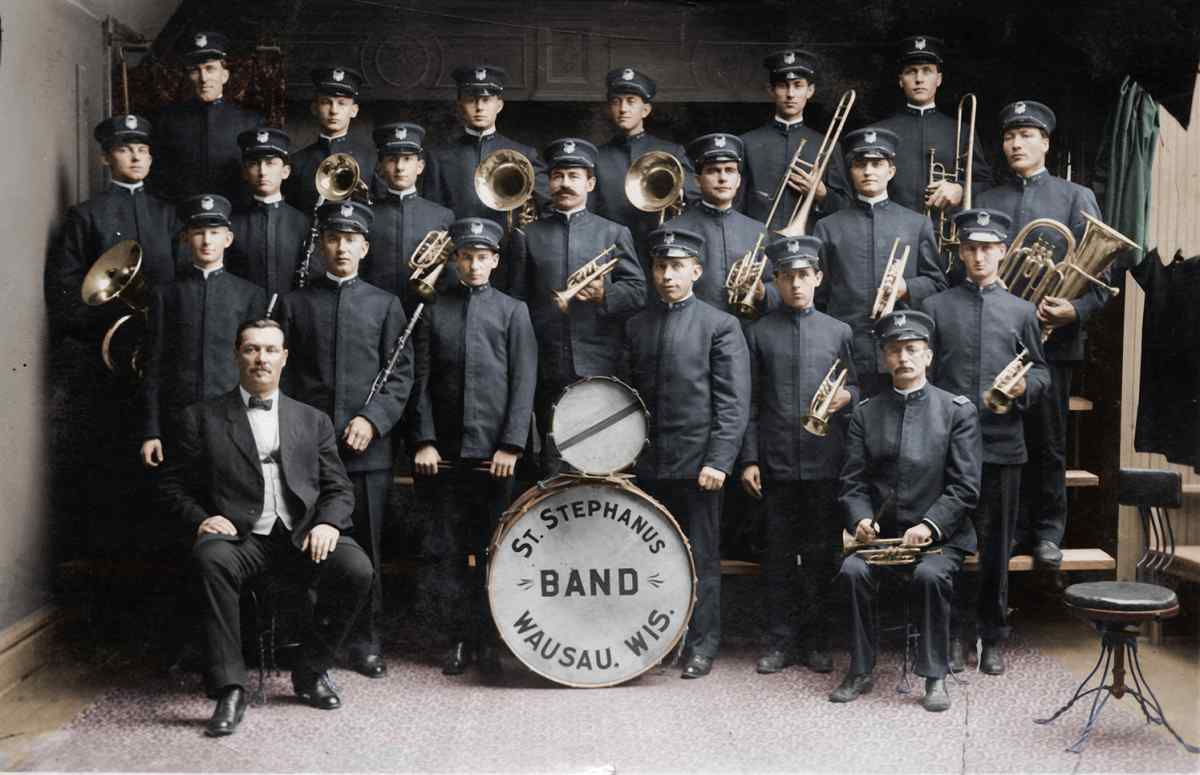
^ The St. Stephanus Band, circa 1912-1917. Cliff Hoene likely the teenager in the front row, standing to the left of the drums.
When Cliff Hoene first joined up with the "St. Stephanus" band, he was given an alto horn, and later picked up the valve trombone. But at one fateful Decoration Day in 1911 (or possibly 1912), Cliff stepped in to play the snare drum when a band mate did not turn up for the parade due to being sick. He would continue to play the drums for the rest of his career.
Hoene also found opportunities to play in other groups in the 1910s for community events, such as those organized through school, church, and the YMCA.
Becoming "The Singing Drummer"
In 1917, the teenaged Clifford Hoene joined five classmates in forming a small jazz band, called the Wilke Jazz Orchestra. They performed a few times over the year at events, which ranged from a gatherings of few friends through the YMCA to being on the same ticket as the St. Stephen's Band.
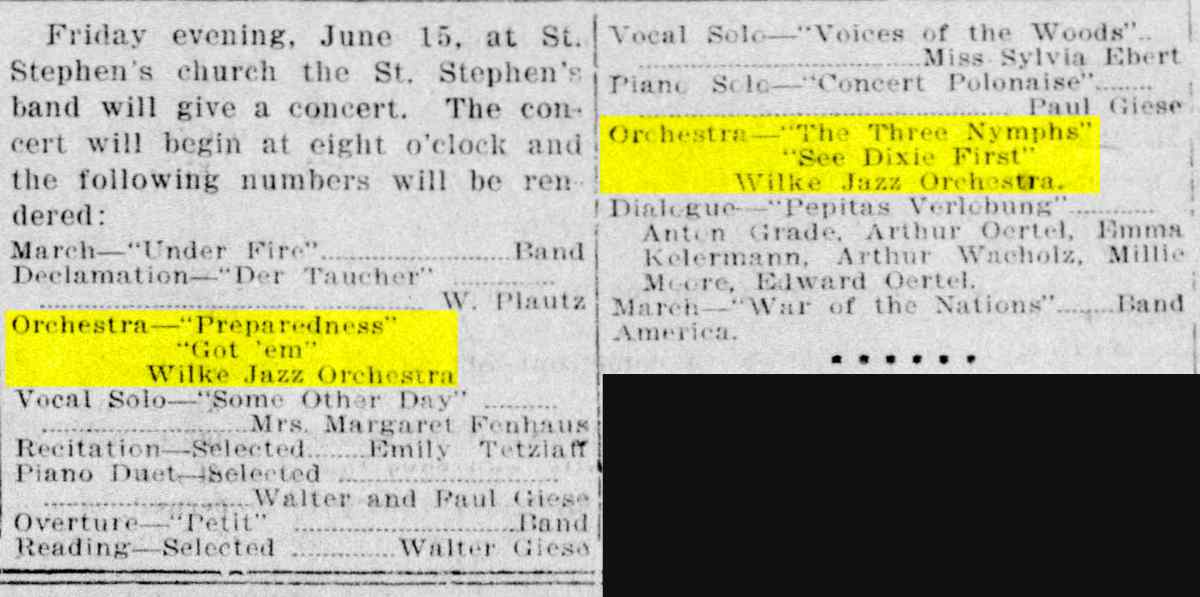
^ This piece from the June 14th Society page of the Wausau Daily Herald shows the Wilke Jazz Orchestra as playing four numbers in a concert held by the St. Stephen's Band
But by the end of the 1917, the Wilke Jazz Orchestra had disbanded (or rather, stopped performing), possibly because the group's leader/violinist Juilus Wilke had moved to Chicago.
And yet by this point, many in the music business around town had noticed the talented Cliff Hoene, and he was occasionally asked by bandleaders like C.S. Cone to sit in with their groups. Years later, he would remember playing shows for Cone at the Grand Opera House:
"We used to get 25 cents for rehearsal and 50 cents for each show when we played the theaters in those days." Cliff said. "Sometimes we played seven nights a week, and I was rich!"
-Quoted by Dan Carlsson in his article "Mr. Old-time Music" for the Wausau Daily Herald (April 20, 1973)
During the First World War, Hoene looked to play in military bands of the day. He traveled down to Chicago in 1917 to audition for John Philip Sousa's U.S. Navy Band (he was rejected for being color blind), but found a place in Frank Dana's new military band for the 10th Infantry of the Wisconsin State Guard the following year.
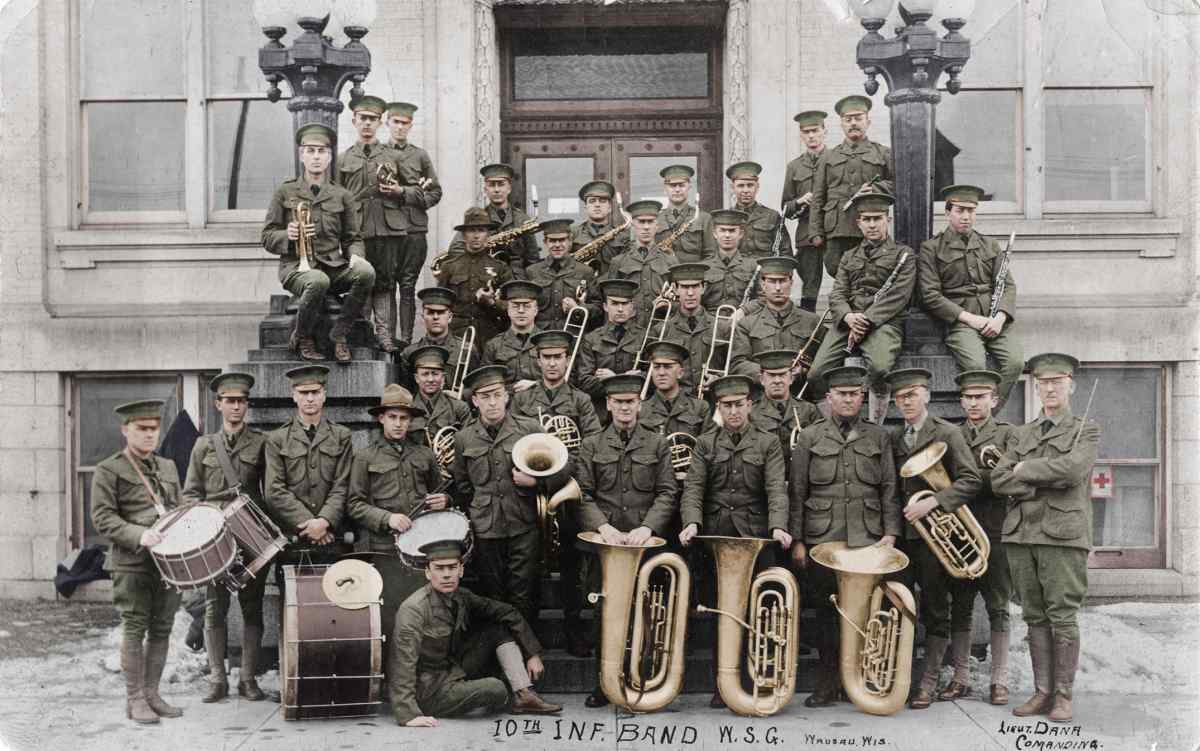
^ The 10th Infantry Band of the Wisconsin State Guard, late 1918 or early 1919. Cliff Hoene standing fourth from the left, wearing campaign hat.
The Wisconsin State Guard was formed during World War I, to replace the Wisconsin National Guard, which had been mobilized and integrated into the U.S. Army to fight in Europe. The Wisconsin State Guardwas made up of men and boys who were too old or young to serve normally, but who wanted to contribute to the war effort in some way. Wausau became home to Company C of the 10th Infantry, and they offered to put together a band for the 10th Infantry. This band was headed by venerable band leader Frank Dana (succeeded by B.F. Schultz after Dana passed away in early 1919).
During his time in the 10th Infantry Band from 1918 through 1921, Hoene met other like-minded musicians. And in 1919, Hoene joined trumpeter George "Windy" Foster, clarinetist William Ibs, and saxophonist George Egner, to become a founding member of the Metropolitan Orchestra to play "jazz."
The Metropolitan Orchestra
The new band originally used the name "Outlaw Jazz Orchestra," but by the end of 1920 they settled on using the more presentable name, "Metropolitan Orchestra."
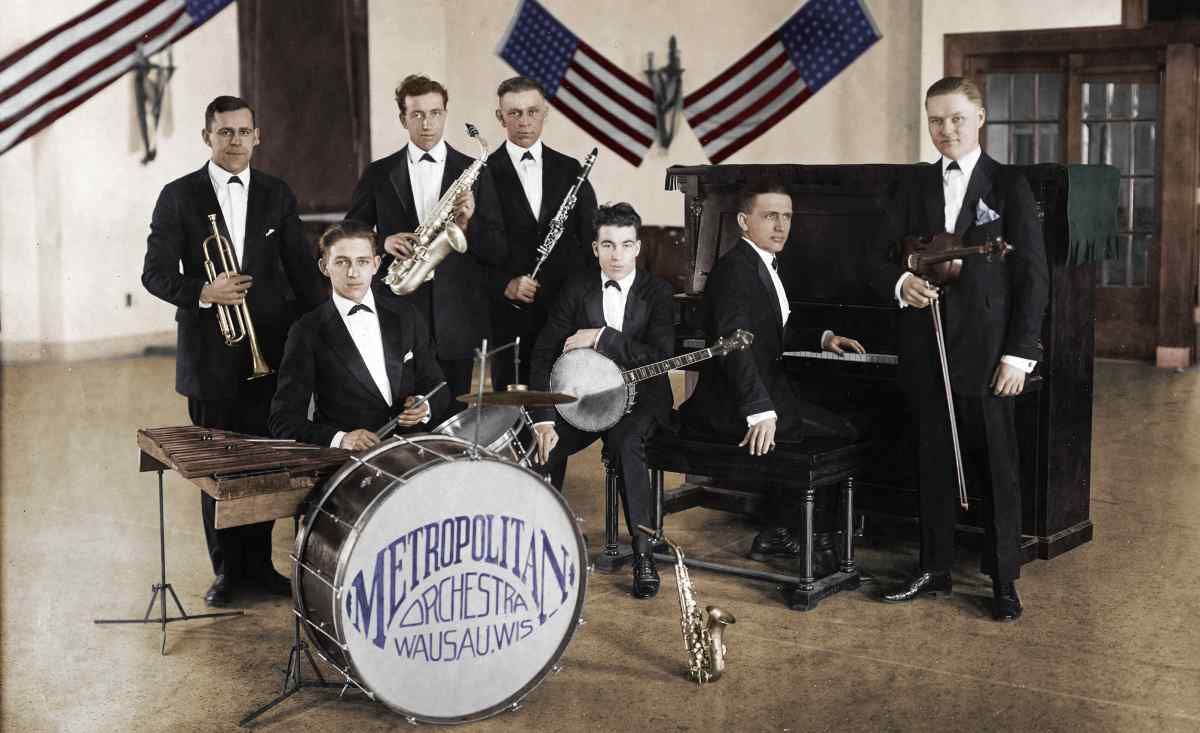
^ Members of the Metropolitan Orchestra in 1921. From left to right: George "Windy" Foster (trumpet), Hoene (drums), George Egner (alto sax), William Ibs (clarinet), Bud Hanson (banjo), Wallace Schymanski (piano, manager) and Carl "Swede" Anderson (violin).
They weren't the only band at the time playing jazz, and by the end of the 1920s a number of musicians put together "orchestras" to play the popular music of the day. One of the more illustrative examples of these groups was B.F. Schultz' "Schultz's Harmony Kings," which billed itself as
A Strictly High Class Combination
Saxophone-Banjo Foxtrots
Beautiful Marimbaphone Waltzes
All the Latest New York Hits.
While some people took to the new musical style being called jazz because of the novelty (especially shown through the instruments), it would evolve to become the unquestioned popular music of its time.
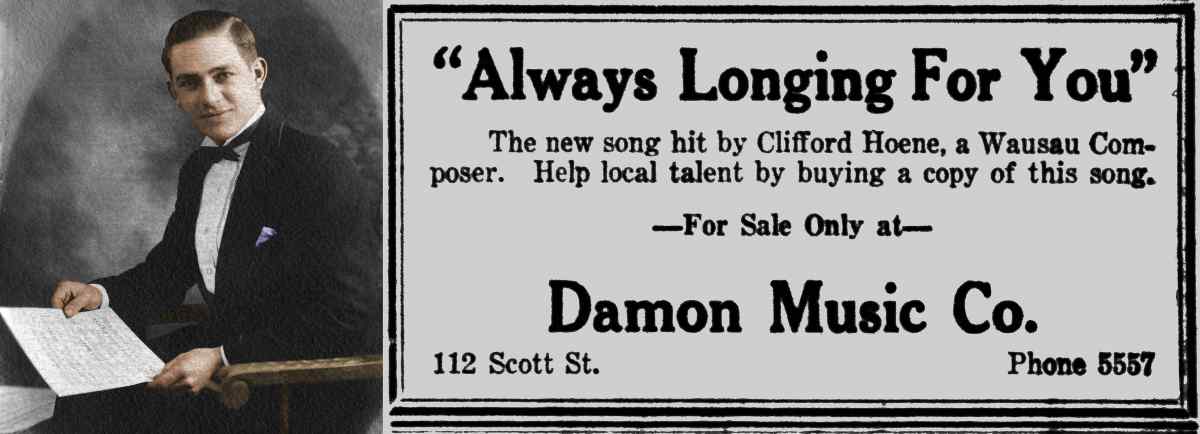
During this time, Hoene branched out from playing the drums to singing and even dabbled in composition. Around 1924, he found some success with a song he wrote entitled "Always Longing for You." The sheet music was sold at local music stores, and Hoene (and occasionally others) performed the piece across the region, from dance halls to a performances broadcast over WLBL radio station in Stevens Point.
After gaining some recognition thanks to his hit song, Hoene left Wausau in 1925 to try to make a career in music down in Chicago. He took a full-time job working at food wholesaler, and a part-time jobs at a local radio station as a drummer and vocalist. This time gave Hoene some excellent experience in show business, including finding a place in the local vaudeville scene, but eventually he discovered that Chicago was not really for him. He returned home to Wausau in 1926.
Cliff Hoene's Orchestra
Upon returning home to Wausau in 1926, Hoene found to his surprise that many from his hometown had followed his brief career in Chicago with interest. Not long after he returned home to Wausau in 1926, the singing drummer was asked to put together an orchestra by the Eagles Hall. This band went by a few names over the next few years, including the "Rhythm Orchestra" and later the "Eagle's Orchestra." But in 1930, he showed up for a New Year's Eve gig at the Wausau Club, and found that they had listed the group as Cliff Hoene's Orchestra.
"That's what they called us in the program," he chuckled "and that's what we became."
-Cliff recounting the story to Dan Carlsson of the Wausau Daily Herald in 1973
But whatever name it went by, Hoene's Orchestra quickly became one of the most popular dance bands in Central Wisconsin.
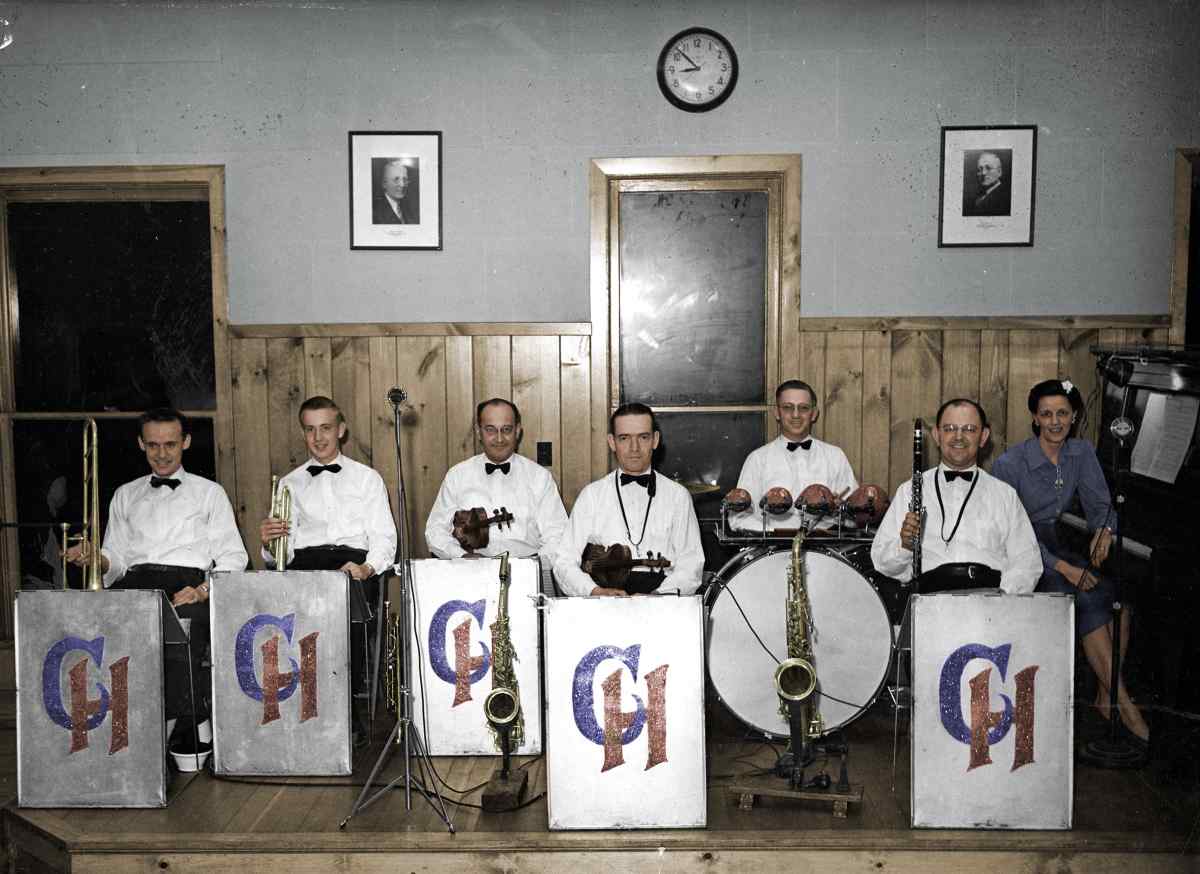
^ A performance of the Cliff Hoene Orchestra in 1942.
Over the next 35 years, the Hoene band traveled the region playing gigs as much as three or four nights a week. They played for audiences at charity balls, dances to benefit fire and police departments, and hundreds of proms. Looking back at the books, he estimated that the band played at least 342 dances for high school and college students.
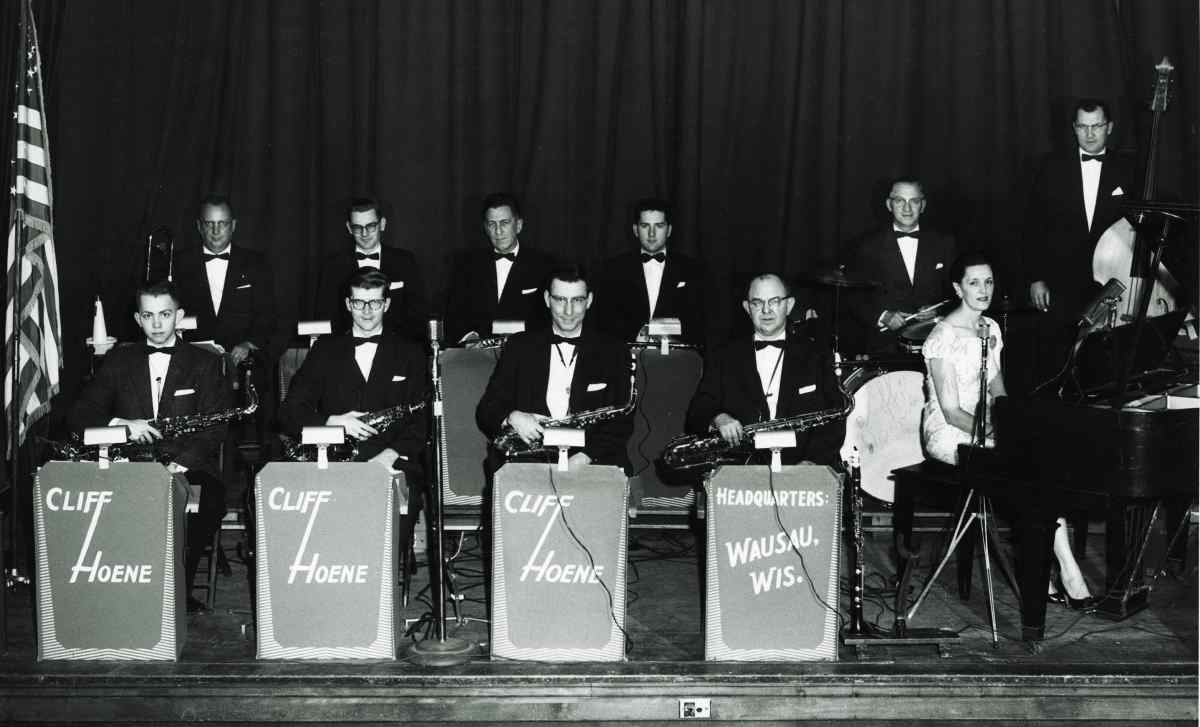
^ The Cliff Hoene Orchestra in 1960 or 1963. Musicians were identified as (left to right): saxophones (front row) James Radloff, James Hanke, Fredrick Zender, and Edward Drews; brass (back row) August Roeber Lee Glasel, Ulrich Schmidlkofer, and Dick Schroeder; Hoene on drums, Adelle Granz on piano, and Buck Leverton on double bass.
But by the 1960s, the band was slowing down. In 1965 Cliff's wife Gertrude passed away. As Gertrude was the bookkeeper and accountant for the band (as well as being an accomplished musician in her own right), and so Cliff felt it was time for the dance orchestra to end. Besides, Cliff saw first hand how his style of music was becoming less popular, and how live music was enjoyed less and less.
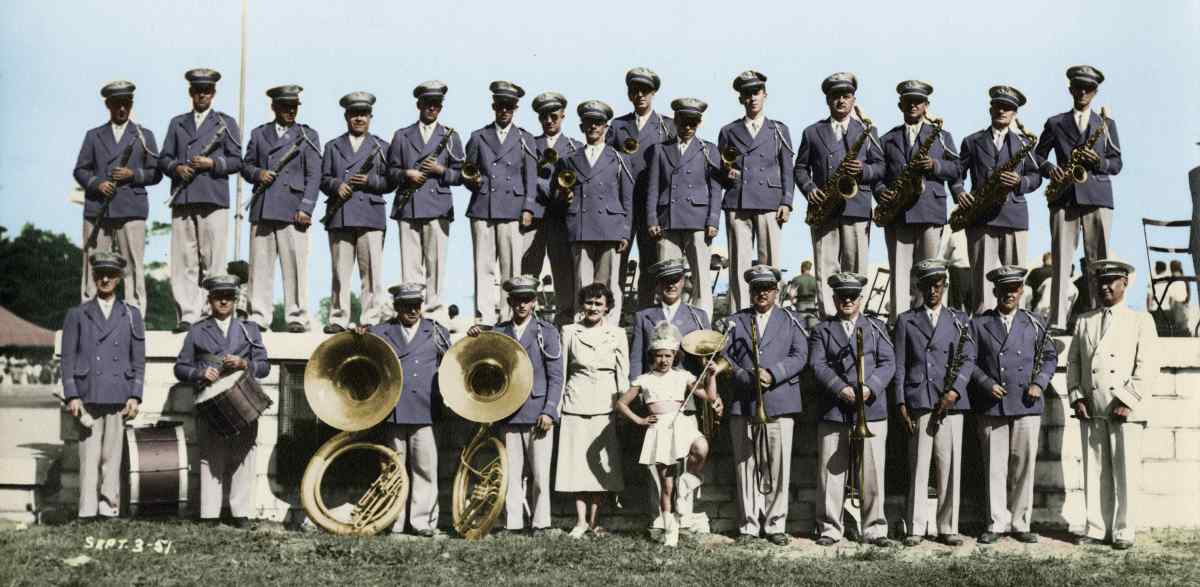
^ The Wausau Municipal Band at the Wisconsin Valley Fair, 1951. Cliff Hoene playing snare drum, second from left on the ground.
Even though Hoene was no longer running his own band, continued to play music in the area. He continued playing with Wausau's community band, as it changed from the 10th Infantry Band during WWI (1918-1921), to the 128th Infantry Band between the world wars (1921-1940), the Wausau Municipal Band (1941-1965), and finally as the Wausau Concert Band (1965-present). He also occasionally played with groups like the renowned Dan Gruetzmacher Orchestra.
Cliff's Legacy
Several years after Hoene's death in 1975, his sister-in-law donated a collection of photographs to MCHS, which illustrate not only the long and successful music career of Clifford, but also the wider music scene in the Wausau area. Some of these stories deserve their own discussion, but it would be hard to find a better example of a musician that shows the musical tastes of Marathon County in the early twentieth century than Clifford Hoene.
* All of the pictures that include Cliff Hoene are from this collection (except for the St. Stephanus Band). Color pictures were colorized in 2019 by Ben Clark.
